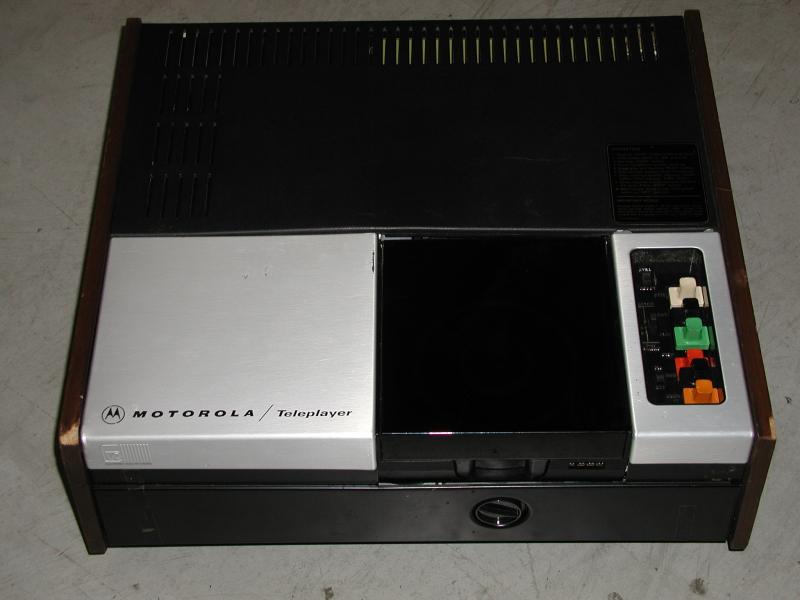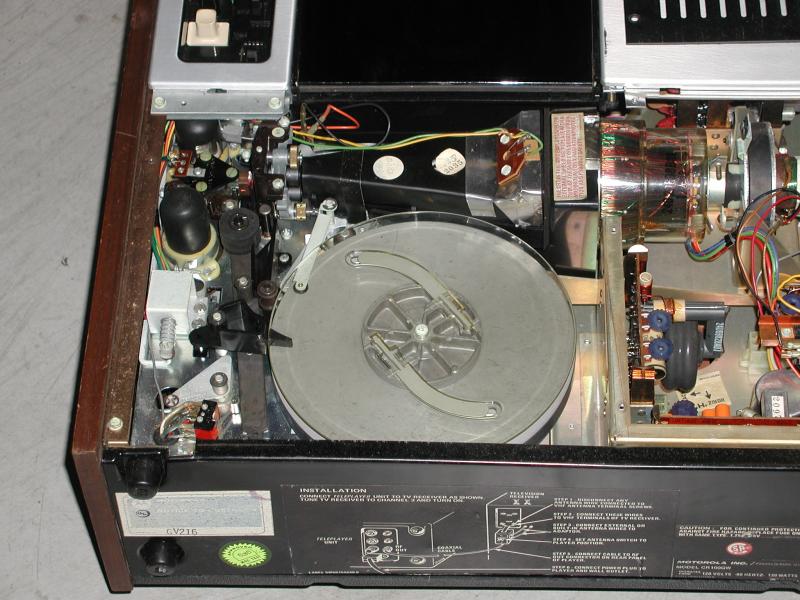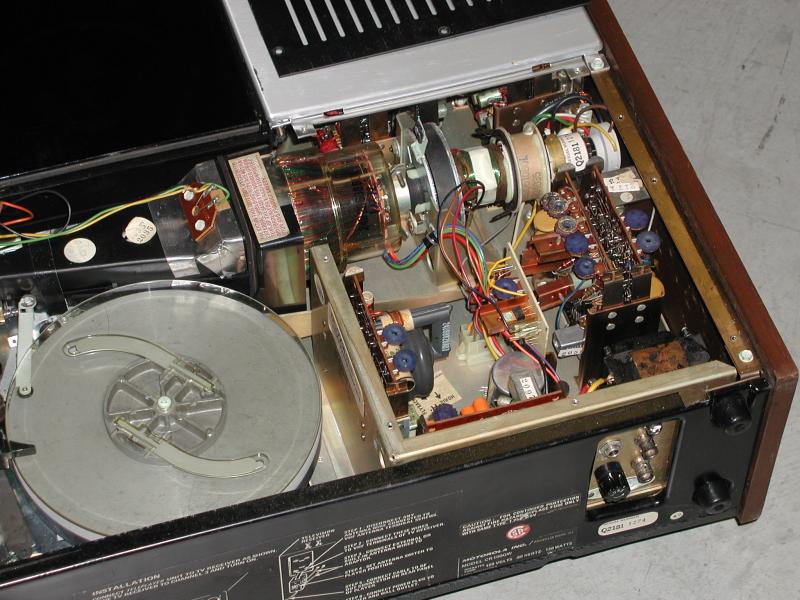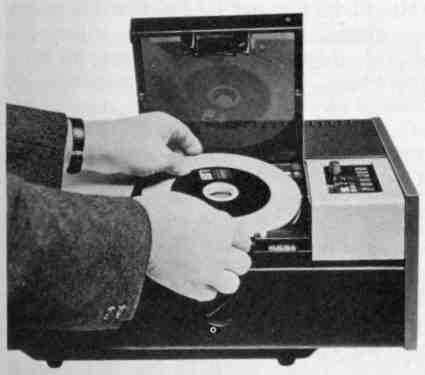| LabGuy's World: 1968
Motorola EVR Video Film Player
New Photos! 020415   
Motorola EVR Video Film Player Technical Details The EVR System, which stood for, Electronic Video Recording, even though it couldn't record! A photographic film based, video play only system. EVR, developed by CBS in 1967, was the brainchild of Dr. Peter Goldmark, developer of the CBS field sequential color TV system, the Chrysler Highway Hi-Fi. and the 33-1/3 RPM Long Playing (LP) record. LabGuy's World has obtained this unit from ebay. The original unit, from my collection, had turned up missing! Lost in a move? Stolen? Who knows? But, once again, I have an example of this marvelous system. Now, does anyone have any films? I can probably transfer them to tape for you! In the first photo, we see the machine in all its splendor. The second photo is a detail shot of the film path. Film traveled downward, in the photo, past the scanning region, through the capstan and pinch roller and ultimately ended up in the take up reel. On the left side of the photo, the two photomultiplier tubes can be seen. They are the black dome shaped assemblies. In the third photo you can see the scanning CRT with all of its scanning coils, focusing and centering magnets and all. This tube contains an ultraviolet short persistence phosphor which is optimum for this type of service. (See my description of flying spot scanning in the following section: B&K 1077 TV analyst). Electronics of the late 1960s was nowhere near the state of the art that we enjoy today. In fact, this unit contains three vacuum tubes! However, that didn't deter the engineers from tackling the design of some incredibly complex consumer products back then! Besides, Dr. Goldmark through his work on mechanical television was never able to kick the "wheels and gears" habit. . The following text comes from a November, 1967 issue of Electronics World magazine: CBS TV FILM DEVICE - The recent announcement by CBS Laboratories of a new TV recording system does not concern a new type of video tape recorder, but consists essentially of a "super 8" size movie film which is electronically scanned and converted into video signals. The master film can be prepared from video tape, movie film, or live pickups and a number of prints are then made which can be used for viewing on TV sets. The outstanding features of the CBS development are the use of new, strong, flexible and extremely thin film material, similar to magnetic tape, but containing movie pictures of great resolution. Unlike movie films, the new CBS film moves continuously, without the pull down and shutter effect, and without sprocket holes. The optical transducer for the TV playback device apparently consists of a light source and photo pickup. While CBS had not divulged the exact method of playback, a type of flying spot scanner, such as used in TV studios, could provide the means of transducing the photographic pictures into video signals. Synchronizing the information, in the form of black and white markings along the edge of the film, can provide the frame by frame synchronization. For the reproduction of color pictures, two separate frames, side by side on the film, are used. One frame contains the "black and white" picture content while the other frame provides the color information. This is compatible with the present color TV system where the Y signal contains the brightness information and the color subcarrier contains all of the color information. The actual pictures are much smaller than standard 8-mm movies. Good resolution is obtained by using microfilm techniques. An added feature of this new CBS development is provision for stereo sound, which is also recorded on the film, somewhat similar to the sound track used in 16- and 35 mm sound film systems. The CBS system is intended primarily for educational TV systems where a film is played at a central location can be viewed on TV monitors in different classrooms. For the home entertainment market, the attractions of this system appear somewhat limited. It is now possible to rent or purchase sound movies at relatively low cost. Even if the cost of the CBS playback device is brought down to the projected $270, this is only barely competitive with film which can be viewed on a large screen, rather than from the face of a TV tube. At the present time, CBS is still conducting tests, mostly in school situations in England and does not plan a full scale demonstration of the system in this country (USA) until April of next year. We can conclude that video tape recorders are here to stay and that their eventual application to the home market will not be impeded by the CBS labs development. This development may, however, provide a valuable addition to educational TV and to some other applications where the use of microfilm techniques, combined with TV viewing, will offer a substantial advantage. ~END~ . 
An example of EVR in use. You should see how clever this thing is! It's extremely cool! I'm glad I own one. How much luck is it, that the one I got had about 500 feet of film broken off and still residing on the internal take-up reel? The picture shows a lot of technical details. If you would like more info, write to me! The system used a flying spot scanner to reproduce the image from a special dual frame film, which was contained in a single reel cartridge. One frame contained Luminance data the other, contained the Chromanance. The CRT was raster, which is ultraviolet by the way, was separated into two side by side copies allowing both frames to be scanned simultaneously. Each frame was then picked up by it's own Photomuliplier tube. All in all, this machine contains three vacuum tubes. . There are a lot of these machines on the surplus market still to this day. Has anyone got an advertisement or sales brochure for one of these? Does any one know Joe Kennedy? He was the fellow, who I met many years ago, who had several thousand of these machines. Tell him to contact me, please! [HOME]......[VIDEO RECORDERS MUSEUM] Last updated: January 09, 2005 |